
Footy. That’s what the locals call Australian Rules Football. And the game was supposed to be a good one. We’re not talking some pickup game in a nearby weed patch; we were going to the big house – the Melbourne Cricket Grounds (MCG) by the Yarra River on the edge of downtown, a place that can comfortably accommodate about 100,000 fans.
Better yet, we had help: a reverend from a local church (and avid fan) had invited us to join his footy group, and promised to explain the often inexplicable proceedings on the field. He tended his flock well too: he arrived two hours early to ensure we could all get tickets for such a prime game (at just $22 each!), as well as to secure prime open seating.
He was excited for any excuse to attend this game, as it was an early season match between two of the top teams among the 18 within the premier professional league in the country, the Australian Football League (AFL). And a bit of a grudge match too.
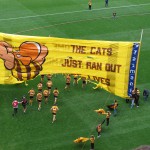
The Hawthorn Hawks had lost to the Geelong Cats eight times in a row, but their last game wasn’t decided until time ran out – as the fans went wild, and the players fretted – with a final shot by the Cats at goal. The Hawks, as the large banner read through which the players soon rushed onto the field, were oh so ready to “cage the Cats.” Would these Cats have nine lives?
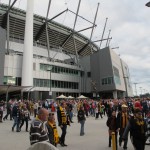
We had walked to the stadium from central Melbourne, just a thirty minute trip down to the Yarra, then along a park and over a bridge passageway. We had seen the MCG before, looming over the grounds of the Australian Open tennis and the River bikeway we had used, but it looked much, much bigger as we neared. Along the way, streams of fans joined the broad flow to the stadium – some in Cats’ blue and white, many others in Hawthorn brown and gold. You could see lots of excited families, children literally of all ages, all walking purposefully together – not from parking lots, but from public train and tram stops in the city.

At the MCG, we connected with the Reverend, our guide, and rode escalators to the third level of the squeaky clean and spacious structure, then walked out into the stands. Before us lay a ginormous elliptical field of brilliantly green grass about 170 meters by 140 meters, or about 210 yards long by 155 wide. We’ve experienced the catch of breath that comes from first seeing a gleaming baseball field, but this was so much bigger. The only markings in all this greenness were the all-encompassing inbounds ellipse just a few meters from the walls, 50 meter semicircles marking the distance to each set of goal posts, a rectangle in front of each goal post, and a small center circle.

And, no it’s not double vision; there are four goal posts out there on each end: two skyscraping ones close together and two others set farther apart. Like soccer or hockey, and unlike rugby or American football, there is only one way to score. No rushing or passing into a non-existent end zone. You only score with a kick through these posts. The tall ones define a “goal” for which you earn six points; kicking through the short ones (i.e., between a long one and a short one) is a “behind,” or just one point. Appropriately, in a country mad for its unique sport, everyone is a master of the 6-times multiplication tables. Harder to tell about the 4s, 5s or 7s tables, though.
When we were first told that there are a lot of behinds in a game, and before further explanation, we started counting the players backsides. Hmm, there are indeed a lot out there, 18 per side. These tend to work in three groups of six, we found, forwards, backmen and midfielders. The latter group includes a hockey line of a centre and two wingers, plus three assisters called for some reason the ruckman, ruck-rover and rover.

Nonetheless, in this huge space, the players need to cover quite a bit of territory for they can be anywhere on the field at any time. In each quarter, one team defends one goal, but there is no offsides at all (ah, like basketball). What’s more, only four substitute players sit by for each team, frequently swapped in when physical wear or tactics demand it. So, we’re told that a player might run up to 14 kilometers (about 9 miles) per game. And (unlike soccer) there’s a lot of scoring.
Just to cover all that space and keep an eye on the helter-skelter of players, there are nine umpires (“do not call them referees or judges”), including two goal umpires and four boundary umpires, and not even counting the two stewards that hang out by the substitutes monitoring how many players are on the field.
Now the game was ready to start. The players all lined up at mid-field for the playing of the national anthem, a paean to the natural wonders and wonderful people of the country. No hired hand sang the words, but most of the fans did, pretty clearly too.
Then all was ready, and here’s some of what we saw.
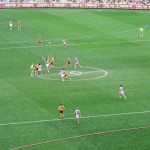
An umpire starts the play by bouncing the ball at the centre of the field and a few midfielders jump for it. Ah, like basketball. With possession a player throws, ah no that’s punching the ball, over to a team-mate. Ah, like volleyball. His teammate runs for a bit and then bounces the ball, ah like basketball again. Then he’s tackled around the waist (no leg tackles and neck/head tackles either), so it’s like rugby or American football. Or is that really hugging going on out there? Everyone starts yelling, “Ball, ball,” probably because there’s a general grab for the ball on the ground. Ah, like rugby. The umpire whistles play dead and awards the ball to the player tackled, no, the tackler, no, to another umpire who tosses the ball in the air for a jump ball. Why one or the other we never figured out – even the veteran fans were at a loss to explain it to us. Perhaps that’s why so many have headsets in their ears, and radios tuned to the game broadcast. We were reminded how U.S. baseball fans would get the skinny on the action long before big screen displays and endless replays (though MCG does have both).

So the players jump for the ball. It’s batted about, and one player gains possession then kicks the ball to another teammate, ah like soccer. The ball rolls about some more till a player picks it up, and either punch/passes it to another or kicks it away again. There’s a lot of kicking. This time the ball is in the air and a player catches it without a bounce…doesn’t matter which side, and play stops. Why did play stop? It’s a mark! And a free kick! What? OK, we’re told, a ball caught on the fly from a long enough kick is a mark deserving a free kick. So, the one who caught it backs up and takes a moment to survey the field, as the defender holds at the spot of the catch, and with another kick down the field, play resumes. Players jostle to catch that kick, bumping and pushing each other, and the other team’s player catches the ball. Ah, a mark and free kick. No, he interfered with the kicker’s teammate apparently, though we’re not quite sure how that differs from normal bumping, grinding and tussling with each other. The crowd reacts vehemently in approval or disapproval of the umpire’s call every time this happens, though more along partisan lines. The ball goes back to the attacking team.
Still with me?
So now the attacker spies on open teammate down the field, and kicks it 20 meters to him. That player finds another 30 meters ahead and reaches him. What’s all that whistling on the field? One more kick to an open player who makes the catch and the ball is within the 50 meter semi-circle which pretty much means a chance to score a goal with a free kick. Ah, the umpire whistles every time there is a mark, and free kick. That’s a lot of whistling and a lot of “frees.”
So, after the umpire has marked the line in the grass for the defender, the catcher backs up about 20 meters, takes a deep breath, starts walking and then trotting toward the goal, and – a few meters before reaching the defender – kicks. Ah, it’s like soccer except more like a free kick in American football since you can hold the ball. The ball gracefully soars through the uprights, and it’s a goal…no, it’s a behind, between the tall post and the far post. A behind? How could the kicker miss the center goal posts from so close? These players can hit a flying duck at 60 meters or bend it like Beckham from impossible angles. Boos and jeers echo around the stadium.
Now, the team just scored on kicks the ball out from the goal, and it’s a mark by his own teammate downfield. No, it’s not, for the ball just hit the ground first. The player gets up and starts to run, but an opponent tackles and throws him to the ground, or rather half-tackles him, as he also punches the ball out of the catcher’s hands. A player (who?) from the other team snaps it up and that team goes on the attack again. He kicks to a teammate (what?) near the sidelines and the ball goes outside the inbounds circle. Who gets the ball? (I don’t know. Third base?) For reasons that remain obscure to us, and in this case even inexplicable to our guide, sometimes one team or the other gets control of the ball, though most times an umpire turns his back to the field at the inbounds circle and gives the ball an enormous heave up and back over the field to put it in play again. Even the umpires have to be in good shape to do that.
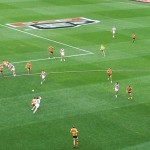
The jumpers bat at the heaved ball (clenched fist, no open hands), one of the attackers scoops it up, quickly bats it to another, then he to a third in a typical triangle formation. With a quick kick, that player reaches a teammate within 30 meters of the goal, and it looks like he will mark it with a clean catch. But no he doesn’t, for a defending team player leaps just in time to bat the ball from his hands. Ah, that’s a spoil! If you’re keeping track, stats for spoils appear regularly on the big screen along with frees. The fans love the spoils of this war.

But this terrific spoil proves to no avail as another attacker scoops up the ball, takes a quick step back, feints right and moves across the goal area, finishing the attack with a deft kick low through the center posts. Goal! Six points. That team’s fans roar; the other team’s fans groan silently or exchange subtle analysis of the weak outcome they just witnessed. The more rabid fans of the goal scoring team, those who sit right between the goals, wave massive pom poms, flags and banners in salute. Wait a moment, was it really a goal? The ball went through the center posts, but might have been touched by a player first. If so, that’s only a behind, one point. Replays appear on the large screens; the umpires confer, but they need an official replay review while all await the result. After maybe a minute, the fans are very bothered – seemingly as much for the egregious delay as for the uncertainty of the outcome. They are accustomed to action that never stops. At one point later on, a few medics ran out to tend a fallen player as the action moved toward the far goal, but then had to retreat quickly leaving the injured behind as the action swung back to their end. Finally, the ruling on the field is…a goal. Pom poms and banners wave; some fans groan. Once a goal is scored, it’s back to the center of the field as an umpire once again bounces the ball to start play.
And it goes on like this, till suddenly a siren blasts though the time clock reads 28:43. That’s the length of a quarter? No, that’s just elapsed time, for a quarter is just 20 minutes of play according to the head umpire’s mysterious official clock…like soccer.
Already we’ve seen 13 scores put up on the board, 5 goals and 8 behinds, and the scoreboard says Geelong 1.5 (11) Hawthorn 4.3 (27). Huh? Remember your 6-times multiplication table. The Geelong Cats had just one goal and five behinds…weak behinds at that, with poor ball handling and choices. 11 points in all. The Hawthorn Hawks dominated with four goals and three behinds, relying on strong defense and precise ball handling/footing. 27 points altogether.
And that’s only the first quarter…we’ve got three more to go! Even as novices, we found ourselves loving the game and the whole experience: the amazing skills of the players; the committed, savvy and non-fanatic involvement of 76,000 fans; the appealing stadium; the entertainment value; the non-stop action; and the frequent scoring. We already were planning to go again (Lord willing, Reverend), even if we remained mystified by some details.
The one-sided first quarter just got worse for the Cats with even more scoring in the frenetic second quarter. By then, with Geelong 5.7 Hawthorn 8.9 (you can do the math on that one), it looked like the Hawks would finally prey on the Cats after all those lost games. But the second half proved very different. Led by their captain, the Cats clawed their way back with pinpoint kicking and bravado marks against a suddenly flustered Hawk defense, finally taking the lead by just two behinds at the end of the third quarter. The game had turned out to be all the Reverend and we had hoped. In the fourth quarter, Geelong built up a bigger lead, but just held on against late Hawk attacks to make this their ninth win a row.
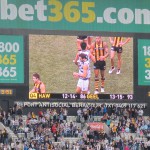
The line score for the game: GEELONG 1.5 5.7 10.12 13.15 (93) defeats HAWTHORN 4.3 8.9 10.10 12.14 (86). That’s just a seven point margin, as you can see.
Maybe a lot of the appeal of Footy comes from how this sport seems to make use of the best bits from a whole array of team sports, while remaining fundamentally different from them. In that respect, the oddest part turns out to be why the Aussie game is played on a cricket ground like the MCG. Though the game appears to have almost nothing in common with the sedate pace and non-contact nature of cricket, reputedly Footy began as a way for cricket players to sharpen their athleticism during the off-season. That’s a connection we haven’t figured out either.
(Also, for more pictures from Australia, CLICK HERE to view the slideshow at the end of the Australia itinerary page.)


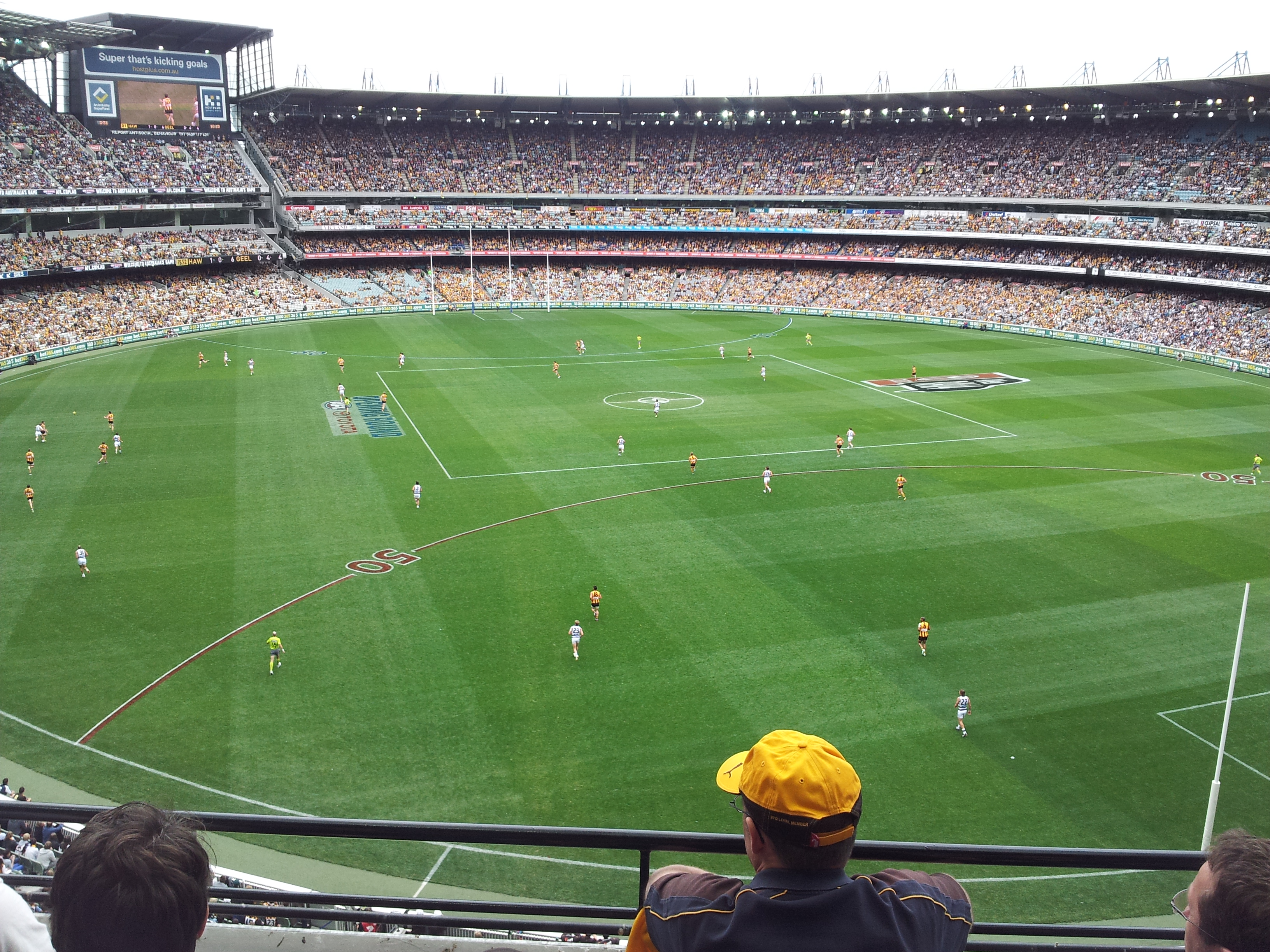




Hi Barry and Nancy
Great commentary of the afternoons events. I think I just learnt some new information about AFL.
As one of the reverend’s footy flock joining you that day and an avid Hawks supporter (as you’re now aware) , I am very impressed that you only chose to post photos of the best team (even though we lost).
Glad you enjoyed this very Melbourne experience!
cheers Leesa
Yes, though the Cats won, we did feel a bit partisan because of you and the rest of the footy flock. After three quarters, and a virtual tie, the group chose the team we all thought would win: at least the Hawthorn Hawks edged out the Cats in that contest. As for play on the field, all the best in the next match between these two teams.